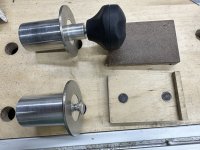I am working on building a Moxon Vise out of hard maple. I was going to line one of the jaws to offer some protection to softer woods. I do not like the cork option so was leaning towards leather. I reached out to a leather supplier and although they have heard of people doing it, they had no knowledge of what style leather (tanning process), weight (thickness?), face type (smooth, suede, etc...), or fastening method (glue, contact cement, etc...). I have searched other forums and online sources and can find references to doing it, but nothing about what type of leather. Would any of you have any knowledge or input on where to gain this knowledge? The leather supplier also wanted my feedback for reference should someone else make a similar request.
Sent from my iPhone using Tapatalk
Sent from my iPhone using Tapatalk



